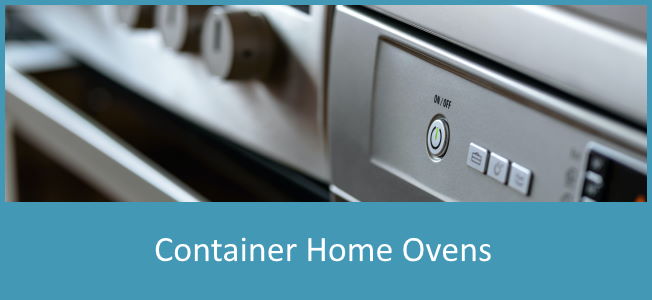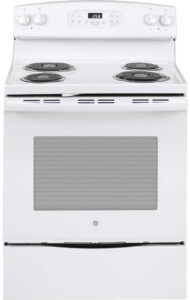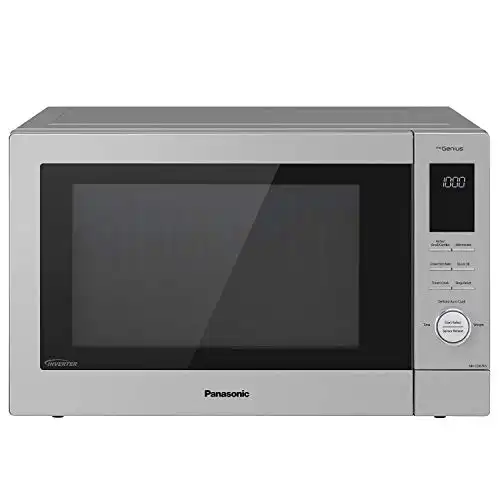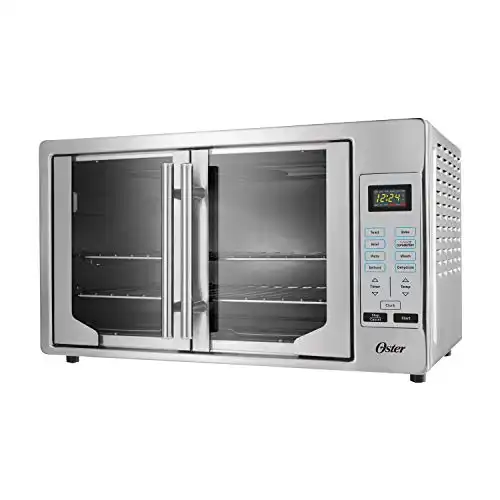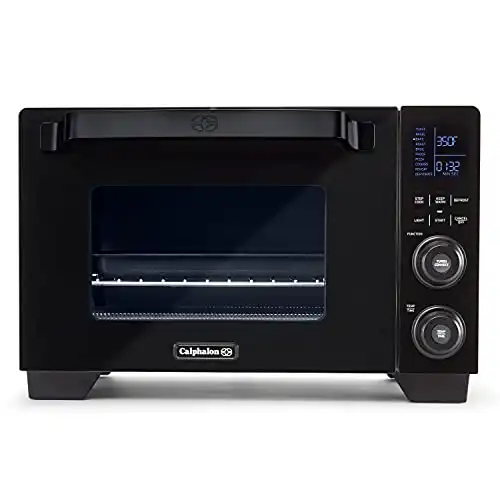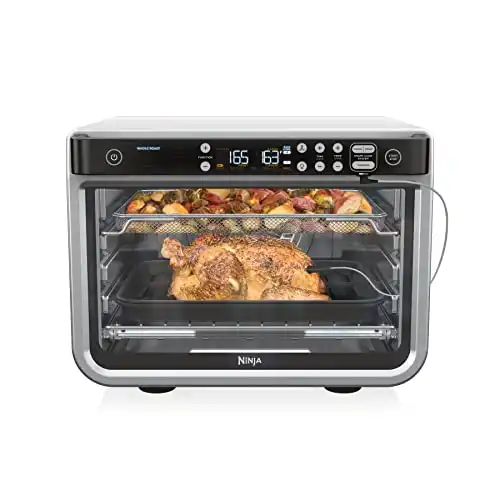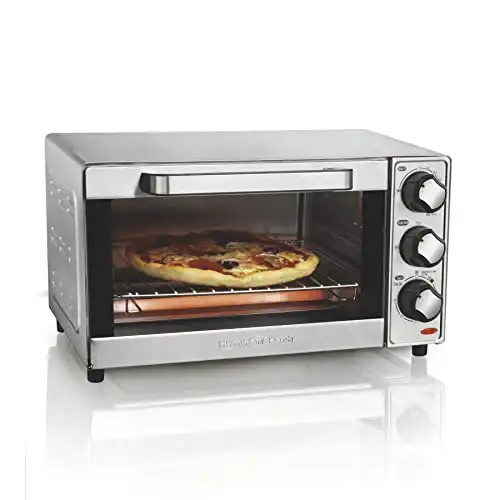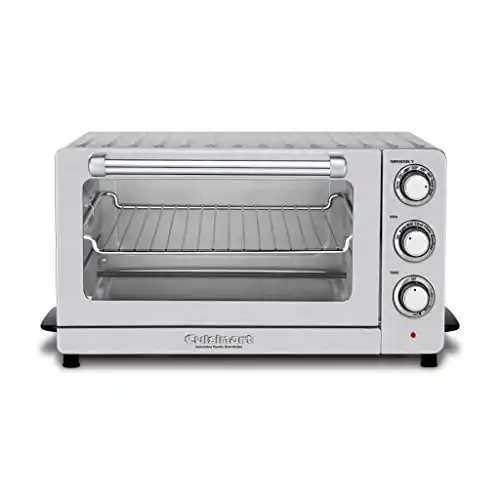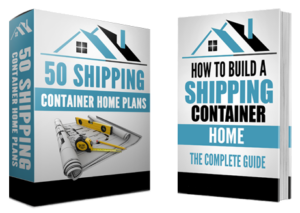If baking bread, roasting vegetables, and cooking pizzas are a few of your favorite things, then an oven has to be one of the necessary kitchen appliances in your container home. But do you need a different oven than what you’d normally put in a traditional house? And what kind of oven should you get? We’re here to answer all your container home oven questions with this informative article!
What is an Oven?
What if we said that you (or at least, someone you know) have been using the wrong vocabulary for your kitchen appliances most of your life?! Well, it’s true.
In many places, words like ‘stove’, ‘oven’, and ‘range’ are used interchangeably. But they are actually not the same things. So before we can even provide our recommendations, we need to be speaking the same language.
An oven is an enclosed box that you use to cook food. Every oven is a type of stove, but NOT every stove is an oven. What does that even mean? Let’s break it down.
Ovens come in all shapes and sizes. They might use electricity, gas, or even wood for heat. And they can have the heat come from inside the container (like most kitchen ovens) or outside (like with a dutch oven used over a campfire). The important thing is that an oven is used for cooking food in an enclosed area.
On the other hand, a stove is a more generic device that converts electricity or fuel materials into heat. It can be in the form of an oven, as described above. Or it can be a cooktop, with burners used to heat pots and pans. A stove can also be used purely for heating up space, with no cooking involved at all.
Put a stove’s cooktop and oven together into one device, and you’ve got what is typically called a range (like the one in the image above). It’s the most common type of kitchen stove in North America. However, in this article, we’ll be focusing entirely on ovens.
What’s so special about Ovens for Container Homes?
Most container home designs include space for a kitchenette, if not a full kitchen. After all, unless your container home is part of a larger compound, you’re going to need somewhere to prepare meals.
If you’re building a large, multi-container home, you can design a large, chef-inspired kitchen to rival anything you’d see with a traditional home. However, if you’re building a compact home with containers, you need to think a little more creatively.
Due to the narrow width of shipping containers, as well as the reduced overall square footage, you have to make every inch count in a tiny container home kitchen. While you can fit regular-size appliances in a small container home kitchen, you’ll quickly end up with reduced space for the rest of the rooms. Instead, you may need to make a few compromises and manage some tradeoffs.
Another point to consider for oven selection for container homes is what to do with the heat. Anytime you use an oven in your home, you’re adding heat to the interior. This is a net benefit during the cool months but is just extra heat for your air conditioner to remove when it’s warm outside.
Therefore, in an ideal world, you want to use only the heat this is necessary to cook your food and nothing more. Making sure you have the right oven for your use-case ensures you won’t be wasting energy by creating excess heat then trying to later remove it from your interior.
Depending on what kind of cooking you intend to do, and how often you plan on doing it, you will need to choose a different type of oven. But regardless, you need an oven that maximizes capabilities while minimizing space. And, if it also saves you money, cooks food faster, or uses less energy, those are great bonuses!
Types of Ovens for your Container House
Within the general oven category, there are actually numerous varieties available. We’ll cover some of the most common types by discussing different characteristics that you can select.
Placement
One of the most noticeable attributes of an oven is where it is mounted or located. This is also tremendously important to think of early on in your project because the location can and will affect your design! There are essentially two main location options:
- Built-in (Wall) Oven: The oven is designed to fit into a purpose-made hole in the wall or cabinets, so you only see the front of the oven. This is a permanent installation method.
- Countertop Oven: The oven comes with its own built-in cabinet (usually metal) and can be set on any horizontal surface, usually a countertop or deep shelf. This type of oven is semi-portable and is the type we’ll mainly focus on in this article.
If you only rarely use an oven, a countertop model lets you stow it away somewhere when it’s not in use. And if you have several rentals containers, you can share one oven amongst several guests. One safety note is that many countertop units can get quite hot on the top and sides during use, so don’t plan on stacking things on top of or near one.
Built-in ovens tend to look higher-end and make your kitchen appear less transient. They also don’t get in the way since they are permanently attached to the cabinetry, which is nice if you frequently use them.
Size
The size of an oven’s cooking area obviously dictates how large of items you can cook. Of course, the size you need is driven by the size of groups you’re feeding and the types of things you cook. Obviously, cooking a couple of pieces of toast versus a large turkey is going to require a different size oven!
As you look for ovens, pay attention to their internal volume, usually expressed as the width, depth, and height of the internal cooking area. Make sure that your favorite pan, pizza tray, or casserole dish can fit in the given space.
Additionally, you’ll need to pay attention to the exterior dimensions as well. Common hangups include not having enough clearance between your countertop and overhead cabinets, or not having a deep enough countertop. Note that most models will require several inches of clearance on the top and sides for air circulation as well.
Heating Method
When it comes to how the oven actually heats up food, there are several methods that are commonly employed. It starts with the simple toaster oven and moves up in complexity from there.
Below are a few of the options available when selecting an oven. Know that in many cases, a single oven may have the capability to use more than one heating technology.
- Thermal Radiation: This is the type of heat transfer used, at least in part, by essentially all ovens. It occurs when a hot surface moves heat through the air to a cooler surface with electromagnetic infrared radiation. If you’ve ever looked into an oven and seen the red-hot heating elements, that’s the source of the radiative heat. For more on how radiative heat transfer works, read our heat transfer article.
- Convection: Newer, higher-end ovens sometimes include a convection setting. Simply stated, this means an electric fan is used to circulate hot air that is already in the oven so that it is more evenly distributed throughout the cooking envelope and into the food. This helps prevent hot spots in your food as well as provides generally faster cook times and lower energy usage.
- Microwave Radiation: Yes, a microwave oven is in fact a type of oven. Microwaves work by using electromagnetic waves (at a different frequency on the spectrum than radiative heat, shown above) to heat water molecules in the food itself. Microwave ovens are typically their own separate category of ovens, but there are combination devices like microwave convection ovens that exist. We’ll mention one of these combination devices later in the article, but for pure microwave ovens, you’ll need to look elsewhere.
Energy Source
The heat energy for your oven has to come from somewhere, and deciding the source you want to use is an important step in developing your kitchen. In many cases, the price and general availability of different energy types will dictate which option you choose, more so than your preference for their performance.
- Gas: Using a gaseous fuel means great heat that many professional chefs prefer, but you’ll usually have to deal with exhaust emissions through a flue pipe to the outdoors. You’ll also obviously need a source of gas, either a bottle or piped line from your utility company. We actually discuss the different types of gas fuel available in our article on water heaters, and recommend you have a quick look there if you aren’t familiar with the different options!
- Electricity: Most ovens these days are powered by electricity using resistance heaters that radiate heat. A resistance heater uses a material that resists the flow of electricity through it, creating heat as a result. If you have inexpensive and reliable electricity available, these ovens often a great choice. There are a few subtlely different options shown below:
- Bare Wire: If you look in older, lower-cost ovens and see thin, coiled wire heating elements, this what we’re calling a bare-wire resistance heater. The wire is typically made from several metals, including nickel and chromium. These heating elements work fine, but they are more susceptible to damage and newer options below have improved performance.
- Tubular: The tubular, sheathed heating element is perhaps the one you’re most familiar with. It basically looks like a rigid wire that’s about 3/8″ thick. In reality, it’s the same bare wire heater from above, insulated with a ceramic powder like magnesium oxide, then encased in a tube of copper or steel alloys. Tubular heating elements can be straight or curved like in older stovetop burners.
- Quartz: A quartz heater essentially takes a bare wire heater and embeds it into a glass-like tube made of the mineral quartz, which is much more heat resistant than regular glass. The quartz tube protects the heating element and radiates energy out at an ideal wavelength for heating, which is more effective than the bare heating element on its own.
- Halogen: A halogen heater uses a small halogen bulb that produces significant amounts of both light and heat. They use a tungsten wire filament as the resistance heater, but the sealed bulb contains a special mixture of gases include a halogen gas. This enables a unique chemical reaction known as the halogen cycle and is why halogen bulbs operate so much hotter than traditional incandescent bulbs.
- Ceramic: Ceramic heaters are made of inorganic and nonmetallic materials that have the unique property of greatly increasing their electrical resistance above a certain temperature. These Positive Temperature Coefficient (PTC) ceramics still work in more or less the same way as traditional resistance heaters. However, the ceramics are able to heat up and cool down very rapidly and don’t need to be nearly as hot as their metallic counterparts to yield the same amount of heat, improving efficiency.
- Biomass: Burning naturally occurring materials like wood, husks, pellets, etc. are all consider biomass. These are uncommon in modern kitchens. However, some off-the-grid containers in colder environments choose to use these.
- Solar: The heat energy of the sun, when concentrated with mirrors or a lens, is perfectly capable of cooking food. However, this isn’t something you could keep in your kitchen as it would involve a large apparatus outside with a clear view of the sky.
Cooking Methods
Many ovens can actually do several different styles of cooking, depending on their settings. Here are a few of the most common cooking options for ovens:
- Toasting: Light cooking/browning bread to add a slight crunchy texture
- Roasting: Cooking via dry, even heat that surrounds food and starts to brown the exterior. This also includes the subset of roasting known as rotisserie, where the food is slowly spun in a stationary oven.
- Baking: Traditionally used for bread and desserts, but possible to be used with all types of foods. Baking occurs with a dry, even heat that is usually slightly lower in temperature than roasting.
- Broiling: Unlike roasting and baking, broiling cooks foods via direct, radiative heat instead of indirect, convective heat. It’s done using the top heating element in an oven.
- Grilling: Similar to broiling, except in grilling, the heat comes from below. This is a challenge because most people don’t want their meat dripping all over their oven and making a huge mess, therefore grilling is not common in ovens without workarounds.
- Steaming: When you continuously boil water, steam is formed which can be used for cooking. At sea level, the temperature of steam is 100°C or 212°F, a fairly low temperature for cooking which makes it hard to accidentally overcook food. Additionally, steaming is shown to retain more nutrients in some foods than other cooking techniques and doesn’t require additional fats or oils.
- Pressure Cooking: Pressure cooking is essentially just steaming with a special lid on the container to prevent the steam from escaping. This increases the pressure, which in turn increases the temperature at which the water will boil and thus the temperature of the steam. As a result, foods can be cooked several times faster in a pressure cooker than via atmospheric pressure steaming.
- Convection Cooking: An oven with a convection setting uses a fan to move the dry, even heat of baking or roasting through the oven at high speed. Using convection will cook foods faster and more evenly, although it isn’t appropriate for all types of dishes.
- Air Frying: Air frying is intended to replicate the taste and texture of deep-fried foods without the added fat from being submerged in oil. However, it’s essentially the same cooking mechanism as convection cooking.
- Microwaving: We already covered microwave radiation as a heating method above, but it’s important that we also include microwaving as a cooking method here as well. Microwave is fast but only works on certain types of foods.
So many options! Most modern ovens are going to offer several, if not all of these cooking options. It’s why the dials and menus of an oven as so overly complex these days! Now, how to decide where to go from here…
Choosing the Right Oven for your Container Home
We’ve covered a surprising number of different oven options above, and it’s easy to feel overwhelmed. Who knew ovens could be so complicated!
As you start to think about your specific situation, some of the options will begin to disappear and make your decision either. For instance, if you don’t have gas available in your area, gas ovens are off the table. And if you never eat certain types of foods, perhaps some of the cooking methods above aren’t applicable.
What you’re left with is still a pretty big list of configurations and potential features. There’s no clear way to whittle that down and arrive at the perfect oven for you.
The fact is, many ovens would probably meet the vast majority of your needs just fine. Therefore, our overall recommendation is just to focus on an oven that performs multiple functions so you have the maximum capabilities with minimum space usage. Next, we’ll make specific recommendations for several oven types.
Our Favorite Container Home Ovens
Below, we’ll share a number of different ovens that have what we feel are a great mix of capabilities, performance, and value. Every recommendation we share also has hundreds of 4 and 5 star reviews, so you’re not just taking our word for it!
Best Do-It-All Countertop Oven: Panasonic NN-CD87KS HomeChef 4-in-1 Oven
This thing is the Rolls Royce of countertop ovens. Why? Because in addition to toasting, broiling, and baking, it also does air frying, convection cooking, and even has a microwave. If you only have room for one heating appliance in your container kitchen, a unit that combines the best of both traditional countertop ovens and microwave ovens is perfect.
Best Large Countertop Oven: Oster French Convection and Toaster Oven
Thanks to its bifold French doors, this countertop oven from Oster has the appearance of a much costlier commercial oven, and it’s fairly large for ovens of this class. Per the manufacturer, it’s large enough to hold two 16-inch pizzas, a family-sized chicken, a roast, a casserole, or 14 slices of bread.
Best Cool Touch Countertop Oven: Calphalon Performance Cool Touch Countertop Toaster Oven
If you’re especially safety conscious about certain family members and guests in your container home, this Calphalon model is worth checking out. As we mentioned earlier, most countertop ovens get very hot on the outside, but this model has a cool-touch design that greatly reduces that. Of course, it also has a sharp black cabinet and great features from a dependable brand, so you’re not giving anything up.
Best Countertop Air Fryer/Oven: Ninja DT251 Foodi 10-in-1 Smart XL Air Fry Oven
If you eat a lot of fried foods but want a healthier option, a counter oven model with an air-fryer functionality is a must-have. This all-encompassing model from Ninja is large and includes just about everything you might want including a temperature probe.
Best Small Budget Countertop Oven: Hamilton Beach Countertop Toaster Oven & Pizza Maker
Small and cheap, this Hamilton Beach oven is probably not going to be something you pass down to your grandchildren. However, if you just need the basic bake, broil, and toast functionality and don’t plan on using it every day for meal preparation, this unit might be all you need.
Best Budget Countertop Oven with Convection: Cuisinart TOB-60N1 Toaster Oven Broiler with Convection
We earn a commission if you make a purchase, at no additional cost to you.
04/24/2024 11:50 pm GMT
If you’re looking for a simple, no-frills countertop oven that comes from a good brand like Cuisinart, this is for you. Compared to the Hamilton Beach model above, this unit is larger, more powerful, and includes convection cooking. However, it still has no fancy digital screens or electronics and no bonus features. What you do get is a capable, powerful oven in an attractive stainless steel cabinet.
Summary
We’ve covered a lot. But we hope you’ve found it worthwhile. If you’re going to do almost any kind of cooking in a container, you’re going to need some kind of oven.
But with an eye toward space and energy efficiency, we’ve focused our efforts here on countertop ovens that provide broad functionality, reasonable prices, lower electricity usage, and smaller cabinets. Hopefully, you’ve been inspired to think about the type of oven you actually need based on your performance requirements and have found our recommendations helpful.

